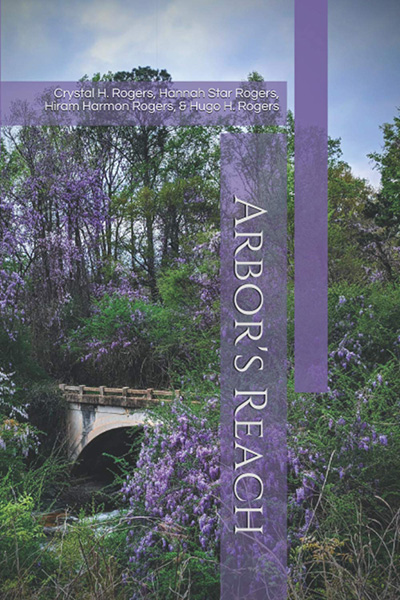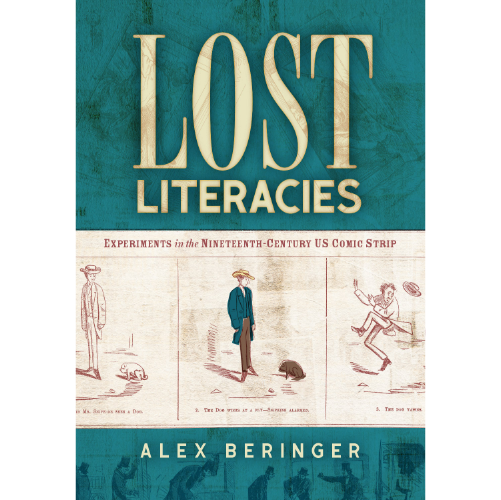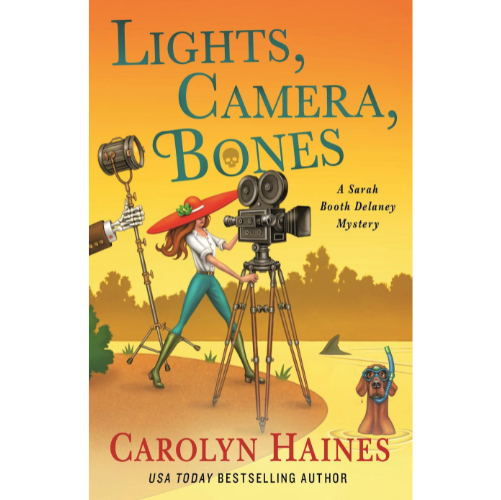By Crystal H. Rogers and Hannah Star Rogers, Photographs by Hiram Harmon Rogers
Edited by the late Hugo H. Rogers
Amazon; 2021
Paperback: $10.98
Genre: Poetry, Photography
Reviewed by Wendy Cleveland

Arbor’s Reach is an extraordinary family collection of poems by Crystal H. Rogers and her daughter, Hannah Star Rogers, and photographs by their son/brother, Hiram Harmon Rogers. This book captures ordinary life in and around Auburn, Alabama. The cover photograph “Wisteria” was taken at the height of the spring color off a dirt road near Highway 280. Deep greens and purples pull us into the natural world that captivates this family so dedicated to environmental beauty and sustainability. Late husband and father Hugo H. Rogers, Research Leader Emeritus at the ARS Soil Dynamics Laboratory in Auburn, edited the collection.
Crystal’s poems reflect her love of environment: “the home, the farm, the garden, and outdoors, and the world we make in our own hearts.” Many of her poems describe the wonders of birds, beginning with “The Goldfinch” in which she describes the experience of holding a “perfectly shingled/exactly painted” creature with its “pounding heart.” This poem ends with both speaker and goldfinch “released/to our destiny,” a thread woven throughout the collection.
In “Hoots” the speaker, unable to sleep, goes outside late at night where she admires the stars as “They inch through/tree arms, peep/around twiggy fingers,” and hears two owls calling: “The bass notes of their voices/root me to this place.” The images and sounds reverberate with the reverence for the rural environment the poet so dearly loves.
Writing from an unusual perspective in “Graveyard Bird Watching,” Crystal situates her speaker beneath the ground. She establishes a somber tone by repeating the adjectives “gray” and “still,” and describing the fog as “soft…slithering in from the bay.” Wishing for comfort “before final sun rises and melts the earth,” she is rewarded as the heron lands “with grace” and stands on her stone.
Throughout this collection we are reminded of the ever-changing patterns of nature and how the consequences affect both humans and other creatures. In “Rain and Beyond” Crystal observes how rain affects soil preparation, easing the pull of weeds or washing away the seed. She asks the reader to consider how the birds “balance hunger against safety/lest waterlogged, they cannot fly,” and how the deer, chipmunks, frogs, and turtles “smile, but mostly wait,” as she does, judging the rain’s goodness by what she had planned to do.
In the gentle and forgiving “Life Among the Blueberries,” Crystal describes a blueberry patch heavily laden with fruit and seeing a fat possum disappearing beneath the azaleas, “its sides strutted, hair standing at attention,” leaving behind bent blueberry limbs and the “ground sprinkled with blue beads.” Rather than bemoaning the loss, she expresses concern for this marsupial who has “babies to care for/worries about dogs, foxes, coyotes.” This consideration for wild animals reaffirms her willingness to share her bounty and to “hope the One/Who Watches takes pity” on her.
A companion piece for this poem is the found poem “A Recipe for Blueberry Stuff” by Katherine Brantley Rogers, Hugo’s mother. The aggregate nature of “stuff” is juxtaposed with the concise details of ingredients and instructions. The final command to “Serve/in a nice blue dish” reflects, perhaps, Katherine’s attachment to this dessert made with fruit picked season after season and shared at the table with family and friends.
The contrast between nature’s known and unknown and the desire for home is evident in many of Hannah’s poems. When contemplating the origin of trees in “The Nativity of Time,” she summons up texture to tie together trees and humans:
Called forth from the ancient acorns
the shadows of the living wrap around
us, snow down leaves or petals or fruits,
there are days when the trees reach out
and touch us.
What is unknown is often reflected in a journey, the wafting of tree leaves in autumn or the fruit that falls from a tree, the pit finding its way into the ground and beginning again the cycle of growth. In “The Ballad of the Stone Fruits” the speaker uses the imperative verbs “abandon” and “roll” to describe the movement of the pits, or stones, on their way down the hill and across the road to “yet at last a float/beneath another bridge with another rock on which another/tree/can grow.” Like the acorns in the previous poem, these stones are very much a part of the journey through both the natural and the human world.
Echoing her mother’s observations of birds, Hannah recalls a special connection between avian and human sounds. “Birds who gather” is a delightful narrative which begins with a woman, perhaps the mother, hustling children into the car, “still pajamed” to see and hear
in a tree at the edge
of our property,
appear more swallows
than I thought existed.
Years later when the speaker is at college, “hundreds of girls/will be talking,” a beautiful metaphor for “a tree full of birds.”
One of Hannah’s most interesting titles is “Like plums picked from a car wreck,” and one of her most arresting images is “two white-haired ladies in the library/of shoes” who “built models of heels/from mason jar lids and bits/of corrugated metal.” The reference to metal foreshadows a crash along the railroad tracks where “plums came at an angle/came with considerable force.” In a clever play on words, the poet offers a hopeful approach with the interchange of “except” and accept” as the plum stones hit the windshield:
fragments but not
reachable except
accept the purple
outside the window
accept the morning
In her ekphrastic poem, “The Monarch, After James Still’s The Fox,” Hannah uses color to describe a sudden flash of light that appears without warning. Still’s speaker is surprised by the gold color of a fox that runs in front of his car at sunset, while Hannah’s speaker describes the monarch butterfly’s orange when thinking about home:
when, rounding
a corner, I’ll see you,
bright enigma
without a plan.
This collection’s beautiful words are further enhanced by Hiram’s color photographs, all taken in 2020. In addition to the striking “Wisteria” on the cover, there are five other photographs. “Blackberries” and “Solomon’s Seal” both highlight dark green leaves with contrasting flowers of white and purple. “Coral Fungi” captures autumnal colors of rust and brown with the brilliant gold of the mushrooms shaped like upright coral. A typical sign of spring, “Dogwood” complements the poet’s theme of nature, as does the striking “Thyme-leaf Bluet,” with its tiny yellow centers.
In Arbor’s Reach the creatively talented and environmentally focused Rogers family shares observations of ordinary life through extraordinary poems and photographs, a gift for all the seasons.
Wendy Cleveland is the author of Blue Ford: Poems.





